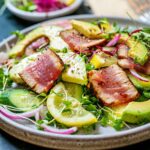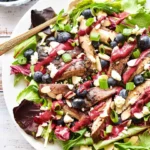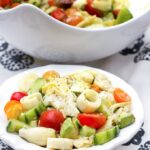Exploring Portuguese breakfast recipes opens up a world of unique flavors and comforting dishes. Portugal’s rich culinary history is filled with delightful combinations that can transform your morning routine. Why not bring the aromas and tastes of Portugal into your kitchen and start your day with something truly special?
With these 16 Portuguese breakfast recipes, you can discover a variety of both sweet and savory dishes. These recipes use simple ingredients to create meals that are bursting with flavor, reflecting Portugal’s rich maritime and cultural heritage. Enjoy the process of creating these traditional breakfasts and add a touch of Portuguese charm to your mornings.
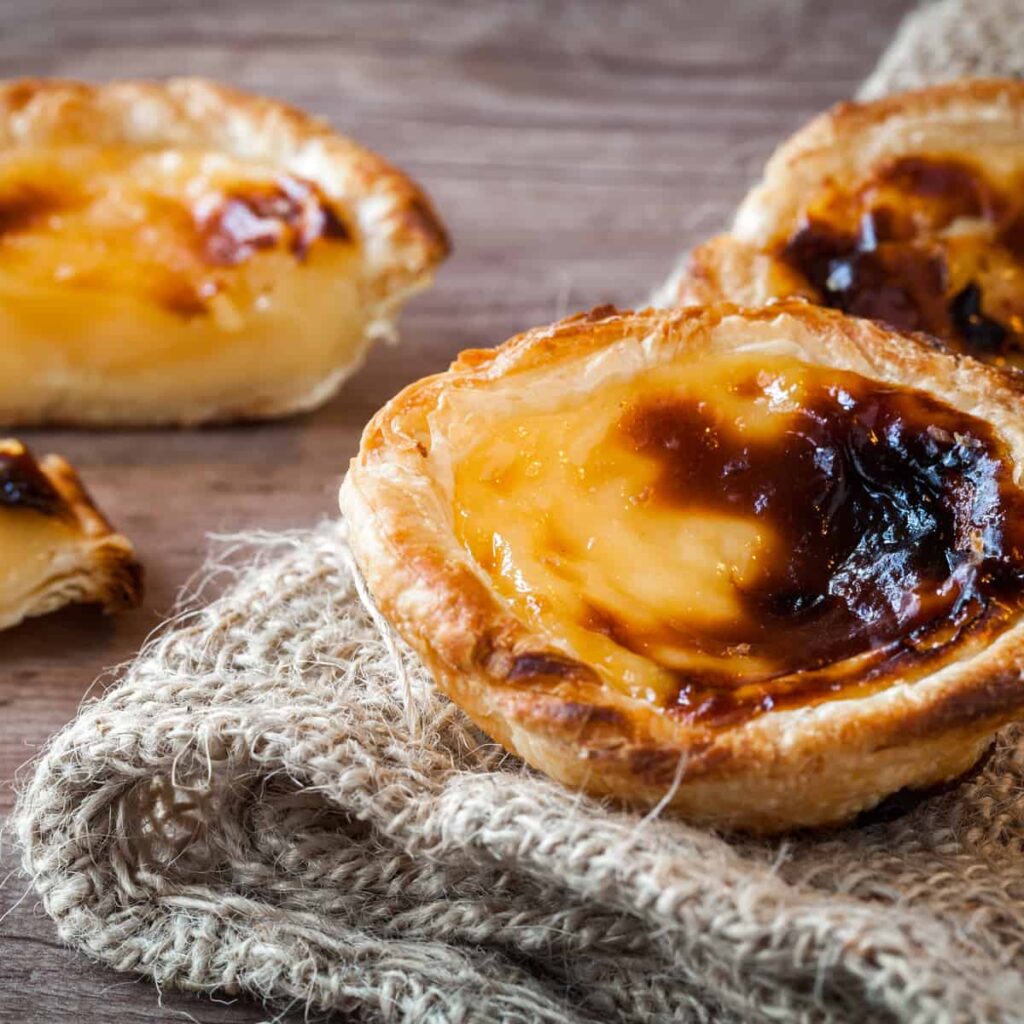
1) Pastéis de Nata
Pastéis de Nata are famous Portuguese custard tarts with a creamy, sweet filling. You might find them at many bakeries in Portugal or places with Portuguese influences.
To make these tarts, you start by preparing a sugar syrup. Combine sugar, water, vanilla extract, lemon peel, and cinnamon stick. Cook this mixture until it reaches 220°F (100°C).
For the custard, mix milk, flour, and salt in another saucepan. Whisk well to avoid lumps. Continue stirring over medium heat until it thickens. Let it cool before use.
Next, prepare the dough. Roll it into a thin sheet and spread butter on it, leaving a small border. Roll the dough into a log and cut it into small pieces.
Flatten each piece and fit it into muffin tins. Pour the custard into these dough cups. Bake in a preheated oven at around 390°F (200°C) until the tops are golden brown and slightly burned.
These tarts are delicious when eaten warm, but they are also good at room temperature. Enjoy them with a sprinkle of cinnamon or powdered sugar on top.
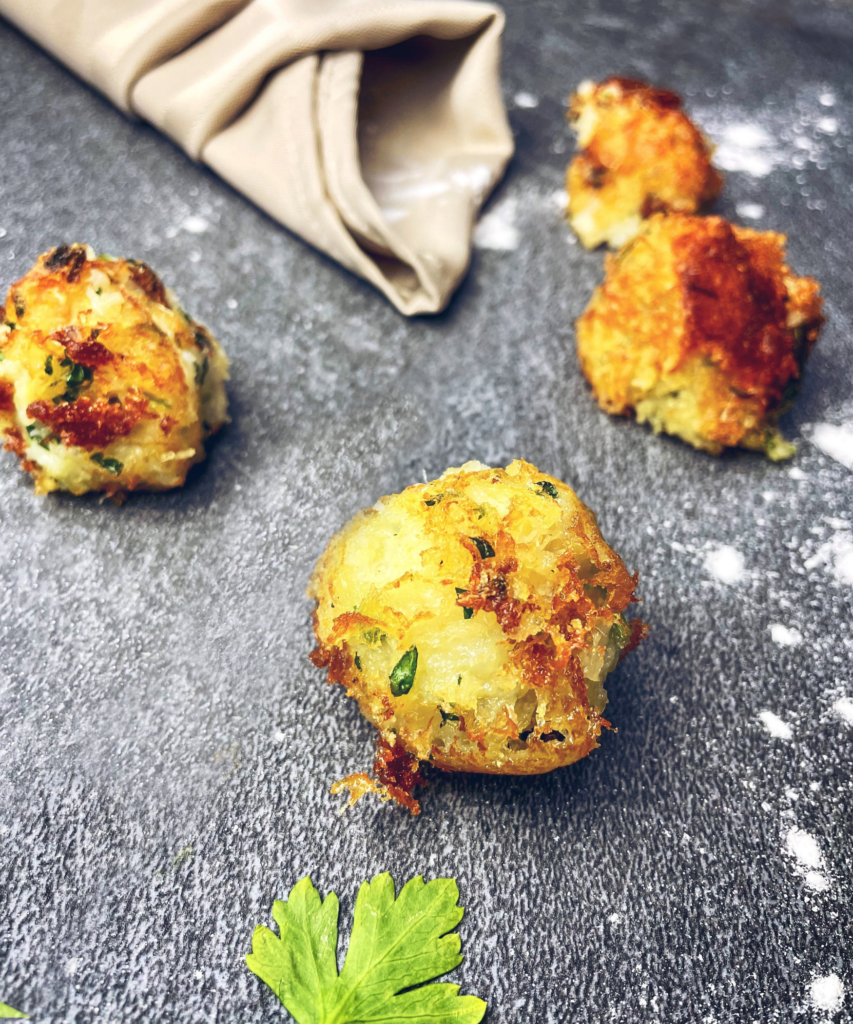
2) Bolinhos de Bacalhau
Bolinhos de Bacalhau, or codfish cakes, are a classic Portuguese breakfast treat. They are made from a mix of shredded codfish, mashed potatoes, onions, parsley, and eggs.
You start by boiling the codfish until it’s tender. Remove the skin and bones, then shred the fish into fine pieces. Prepare mashed potatoes separately.
Combine the shredded codfish and mashed potatoes in a large bowl. Add finely chopped onions and parsley to the mix. Beat a couple of eggs and blend them in as well.
Shape the mixture into small, torpedo-shaped cakes using two tablespoons. This helps to give them their unique, traditional form.
Heat oil in a pan over medium heat. Fry the fish cakes for about 2 minutes on each side until they are golden brown.
After frying, place the cakes on paper towels to drain excess oil. Bolinhos de Bacalhau are best enjoyed fresh and warm, offering a delicious and savory start to your day.
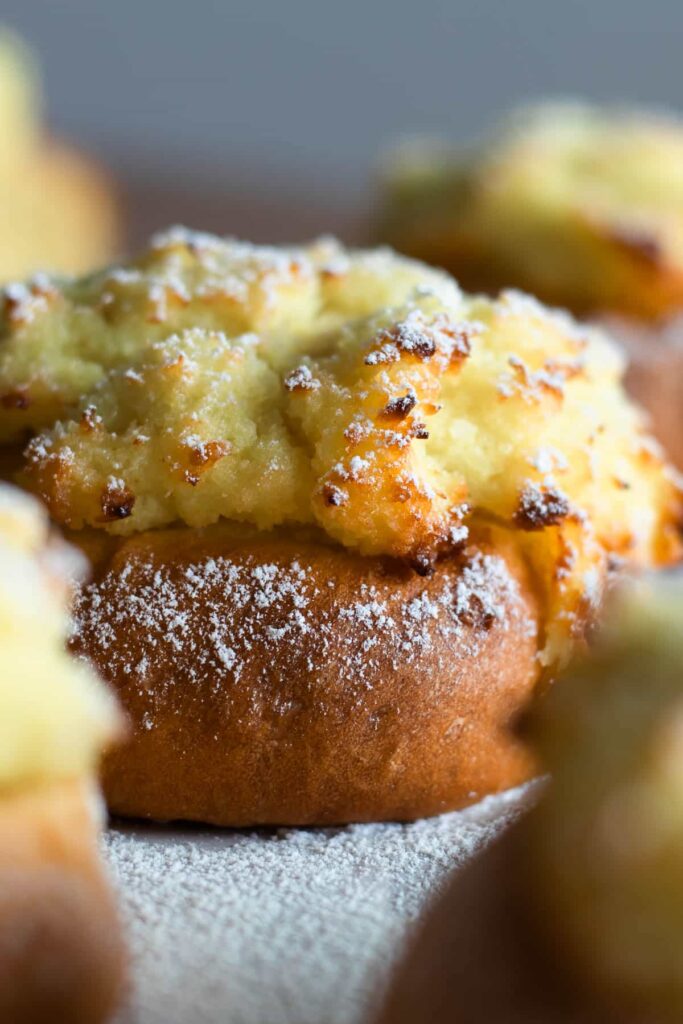
3) Pão de Deus
Pão de Deus, also known as “Bread of God,” is a sweet and fluffy bread with a rich coconut topping. It’s popular in Portugal and often enjoyed for breakfast or as a snack.
To make Pão de Deus, you start by mixing yeast with warm water and letting it stand for a few minutes. This helps activate the yeast.
In a separate bowl, combine flour, sugar, eggs, vanilla extract, salt, and the yeast mixture. Mix these ingredients until a smooth dough forms.
Next, add in softened butter and continue kneading the dough until it becomes elastic and pliable. Let the dough rise in a greased bowl until it doubles in size.
For the topping, you’ll need grated coconut, sugar, and eggs. Mix these together until well blended.
Once the dough has risen, shape it into small rolls. Brush each roll with a beaten egg yolk and water mixture.
Top each roll with the coconut mixture, pressing gently to ensure it sticks. Bake the rolls in a preheated oven at 350°F (180°C) for about 15 to 20 minutes, or until golden brown.
Enjoy your freshly baked Pão de Deus warm or at room temperature. This delightful treat pairs well with a cup of coffee or tea.
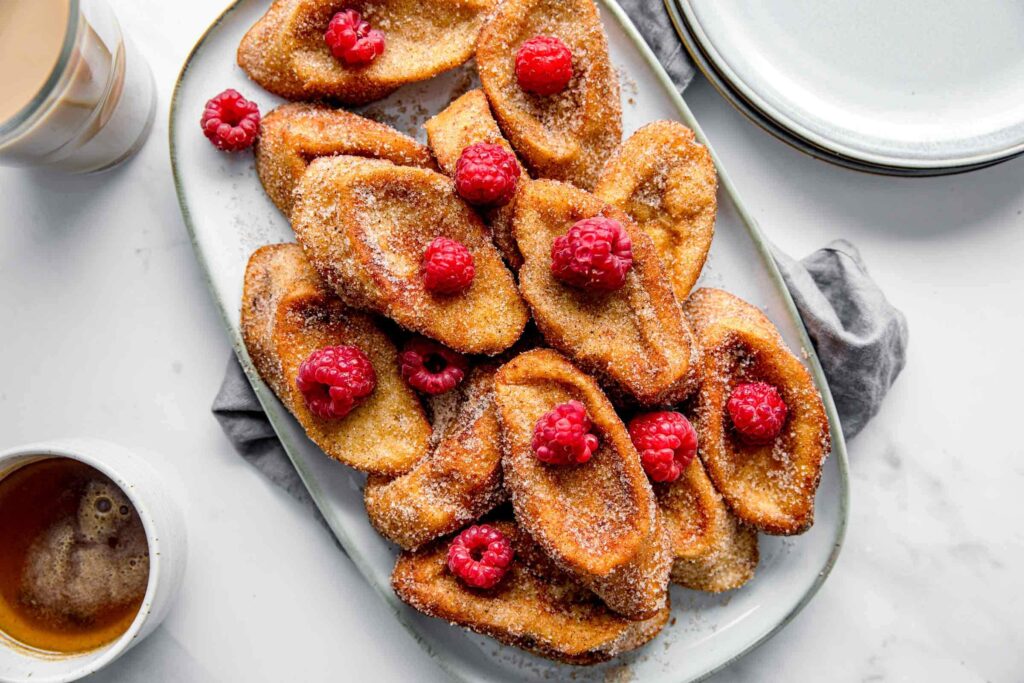
4) Rabanadas
Rabanadas, also known as Portuguese French Toast, are a traditional Portuguese breakfast treat. This dish is often enjoyed during the holiday season but can be a delightful morning meal anytime.
You will need some basic ingredients: bread, eggs, milk, sugar, and cinnamon. Start by mixing sugar and cinnamon in a small bowl.
Next, whisk eggs and milk in a large shallow dish. Dip the bread slices into this egg mixture until they are lightly soaked. It’s best to use day-old or slightly stale bread as it absorbs the mixture better.
Heat oil in a skillet over medium heat. When the oil is hot, carefully place the soaked bread slices into the skillet. Cook them for about 2-3 minutes on each side until they turn golden brown.
Once cooked, you can remove the bread from the skillet and let the excess oil drain. While still warm, coat the cooked bread generously with the cinnamon-sugar mixture.
Rabanadas can be served warm and are often enjoyed with a drizzle of honey, maple syrup, or a sprinkle of powdered sugar for added sweetness. They have a crispy exterior with a soft and flavorful inside, making them a perfect breakfast treat.
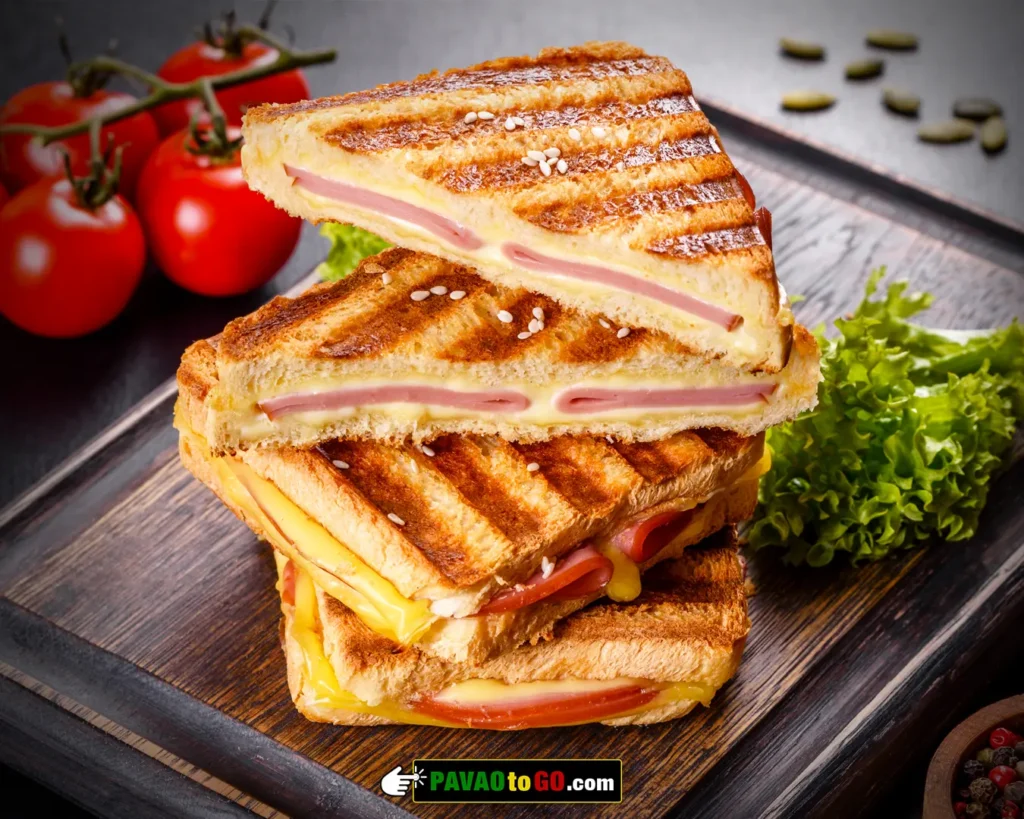
5) Tosta Mista
Tosta Mista is a classic Portuguese sandwich that’s straightforward and delicious. It’s similar to a ham and cheese sandwich but with a distinctive twist.
You’ll need bread, ham, and cheese for this recipe. Portuguese people often use a soft white bread, but you can use your favorite type.
Start by buttering the outside of the bread slices. Place a slice of ham and cheese between two slices of bread.
Next, grill the sandwich. You can use a sandwich press, a frying pan, or even a griddle. Cook until the bread is golden brown and the cheese is melted.
Serve your Tosta Mista hot. It’s great for breakfast, but you can enjoy it any time of the day. Add a cup of coffee or a glass of orange juice to complete your meal.
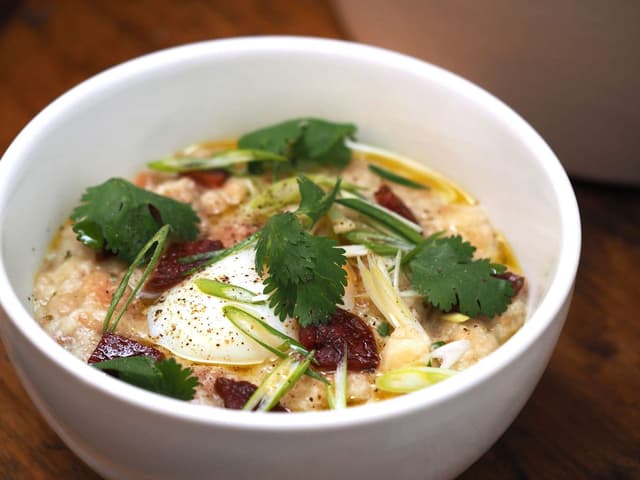
6) Açorda
Açorda is a traditional Portuguese dish, often enjoyed for breakfast. It’s a simple yet flavorful bread soup. The main ingredients include stale bread, garlic, cilantro, olive oil, and sometimes eggs.
To make Açorda, you start by crushing garlic and cilantro together in a mortar. This forms a fragrant paste. In a pot, bring water to a boil and season it with salt and pepper.
Add the garlic and cilantro paste to the boiling water. Stir well. If you like, you can also add poached eggs to the soup to give it a more hearty texture. Break the eggs into the boiling water and let them cook for a few minutes.
Next, add chunks of stale bread to the pot. The bread should soak up the broth, becoming soft and flavorful. Stir gently to ensure the bread mixes well with the other ingredients.
You can serve Açorda straight from the pot. Drizzle some extra olive oil on top and garnish with a few fresh cilantro leaves for extra flavor. Enjoy this comforting and tasty breakfast dish that’s a staple in Portuguese cuisine.
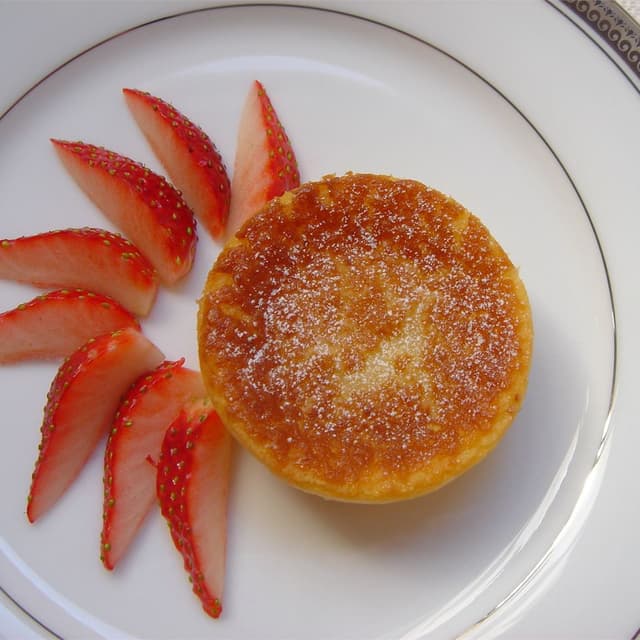
7) Queijadas
Queijadas are Portuguese milk tarts known for their delicate texture and rich flavor. They are a favorite treat, especially at breakfast.
To make Queijadas, start by preheating your oven. Mix sugar and flour in a large bowl. Add beaten eggs, melted butter, and milk, whisking to combine.
Pour the batter into greased muffin tins, filling each cup about three-quarters full. Bake until the tops are golden brown. The tarts will have slightly caramelized edges and a creamy center.
Traditionally, Queijadas include a hint of lemon or cinnamon. These ingredients give a subtle, aromatic flavor that enhances the overall taste.
Enjoy these delicious tarts warm or cold with a cup of coffee. You will love how they melt in your mouth.
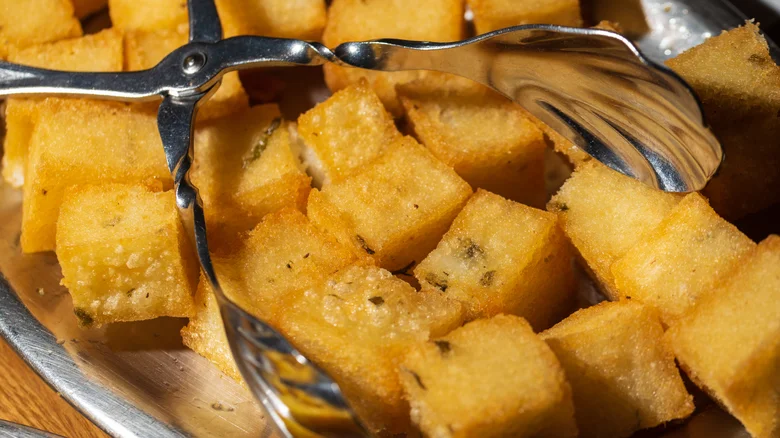
8) Milho Frito
Milho Frito, or Fried Cornmeal, is a popular breakfast dish in Portugal, particularly in Madeira. It is savory and crispy on the outside, with a warm, soft interior.
To make Milho Frito, start by heating water, oil, garlic, and salt in a large pot. Bring the water to a boil.
Slowly whisk in the cornmeal. Make sure to add the cornmeal in a steady stream to avoid lumps. Stir continuously until the mixture thickens.
Once thickened, pour the mixture into a greased dish. Let it rest for about two hours to set.
After resting, cut the cornmeal into small squares. Heat vegetable oil in a deep frying pan over high heat. Fry the squares until golden and crispy on each side.
Serve hot. Milho Frito makes an excellent side dish or a standalone breakfast item. Its crunchy texture complements many dishes.
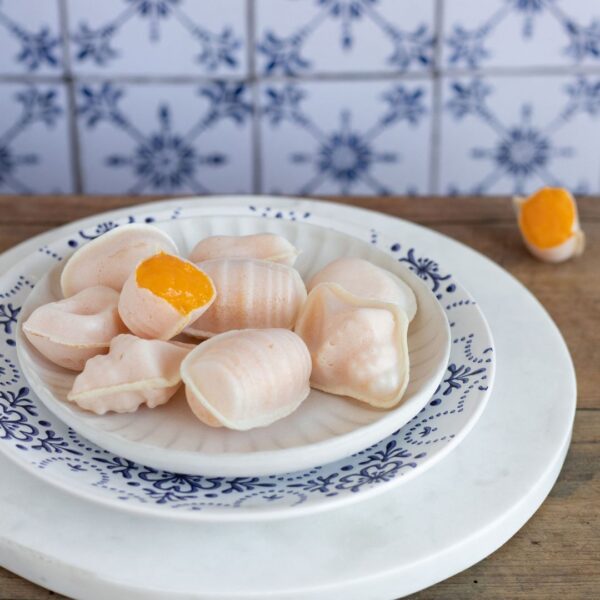
9) Ovos Moles
Ovos Moles is a traditional Portuguese dessert originating from Aveiro. It features a sweet and creamy egg yolk filling wrapped in a thin, wafer-like shell. This unique treat showcases Portugal’s rich pastry heritage.
The filling is made by mixing egg yolks with sugar and cooking the mixture until it thickens. The shell is crafted from wheat flour, water, and a bit of olive oil, creating a delicate casing.
The process of making Ovos Moles takes a few days. On the first day, you prepare both the filling and the shell. The shell, often shaped like clam shells or other maritime shapes, needs to rest and firm up before use.
When making Ovos Moles, precision and patience are key. The filling must be smooth and thick, while the shell should be thin yet sturdy enough to hold the filling without breaking.
To assemble, you fill the shells with the creamy egg mixture and carefully seal them. Each bite of Ovos Moles offers a delightful mix of textures and a burst of sweet flavor.
These treats are not just delicious but also have cultural significance in Aveiro. They are often decorated to resemble sea motifs, reflecting the city’s maritime heritage.
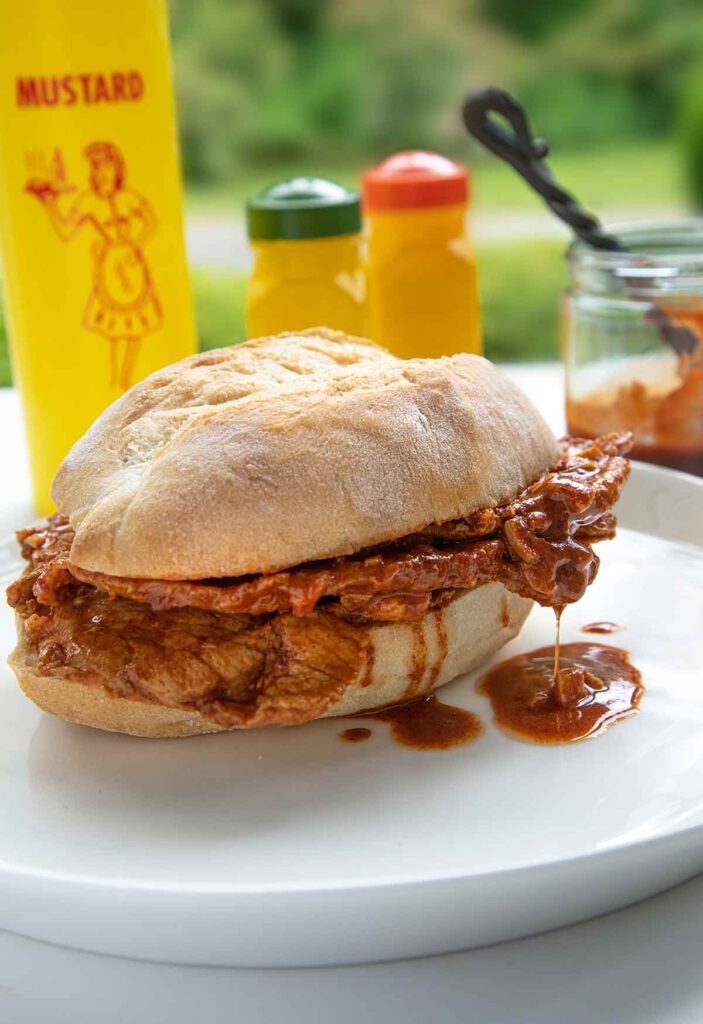
10) Bifana
Bifana is a popular Portuguese sandwich made with marinated pork. It is a common breakfast option in Portugal, especially loved for its rich flavors.
To prepare Bifana, you first marinate thin slices of pork in a mix of garlic, white wine, paprika, and bay leaves. This helps infuse the meat with flavors. The marinating process can take a few hours or even overnight.
Once marinated, the pork is fried in a hot pan with lard or a blend of lard and olive oil. This gives the pork a nice, crispy texture on the outside while keeping it tender inside.
After the pork is cooked, you place it in a crusty bread roll. The bread is often toasted or warmed to enhance the texture. Some variations might include onions or hot sauce for an extra kick.
Bifana sandwiches are quick to assemble once the pork is ready. They are perfect for a hearty and satisfying breakfast. Plus, their portable nature makes them ideal for a meal on the go.
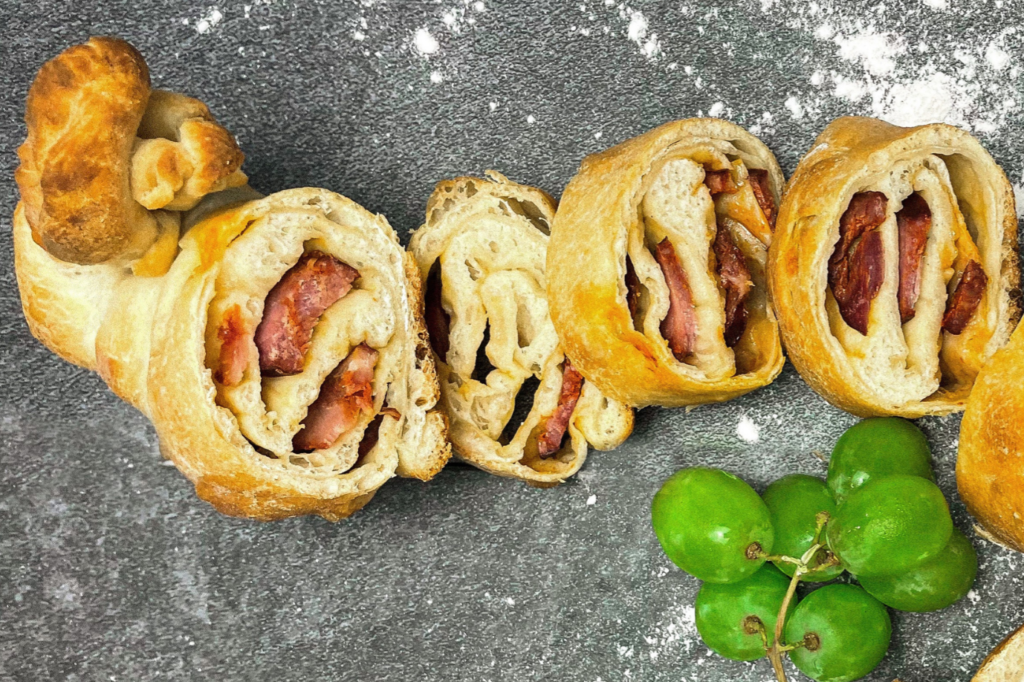
11) Pão com Chouriço
Pão com Chouriço is a popular Portuguese bread filled with slices of flavorful chouriço sausage.
To start, mix flour and salt in a large bowl. Add yeast and mix well. Pour in olive oil and some water. Knead everything together with your hands while gradually adding the rest of the water until you have a consistent dough.
After kneading, let the dough rest by placing it in a buttered bowl. Allow it to double in size. Next, sprinkle flour over the dough and make a small cross in the middle. This helps the dough rise evenly.
Once the dough has risen, flatten it and place slices of chouriço on top. Roll the dough to form baguette-shaped rolls. Place the rolls on a baking sheet lined with baking paper.
Cover the rolls with a damp cloth and let them rest for another 45 minutes. Preheat your oven to 200°C. Before baking, cut the dough 3 or 4 times on the top to allow steam to escape.
Bake until the bread is golden brown and fully cooked. Enjoy your Pão com Chouriço warm for the best flavor.
This bread is perfect for breakfast or as a snack. The combination of soft bread and spicy sausage is sure to please your taste buds.
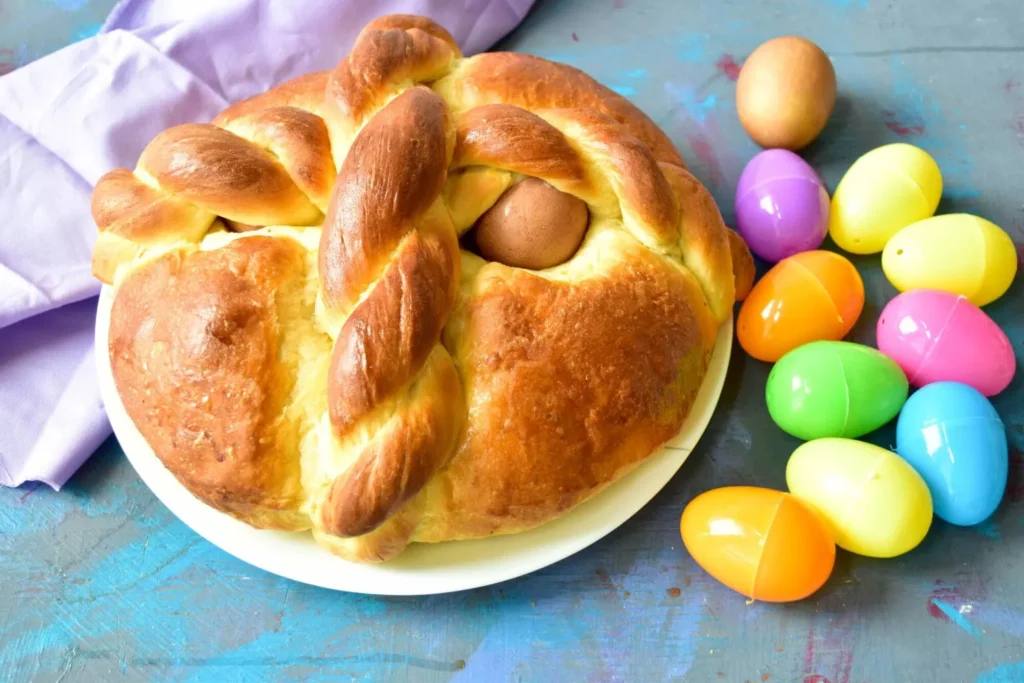
12) Folar de Páscoa
Folar de Páscoa is a traditional Portuguese Easter bread. It’s known for its sweet flavor and unique texture. This bread is often enjoyed during Easter but can also be a great addition to your breakfast table.
The dough is made with flour, sugar, and fennel seeds. Yeast is added to help the bread rise, creating a light and airy texture. Milk and butter are mixed in for richness.
Once the dough is prepared, it is left to rise in a warm place. This step is crucial for achieving the right texture. After the dough has risen, it’s shaped and sometimes decorated with whole boiled eggs on top.
The bread is then baked until golden brown. You can brush it with an egg yolk mixed with olive oil right after baking for a beautiful, shiny finish. Enjoy this flavorful bread with a cup of coffee or tea.
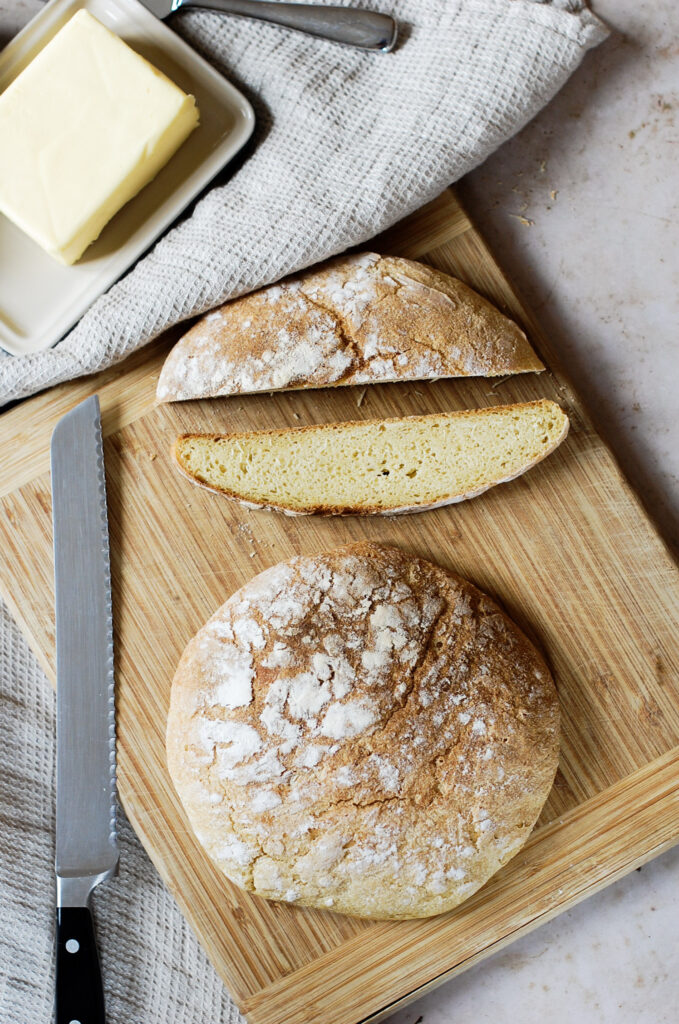
13) Broa de Milho
Broa de Milho is a traditional Portuguese corn and rye bread. It’s dense and has a slightly sweet flavor.
To make Broa de Milho, you start by mixing corn flour with boiling water. Let this hydrate for about an hour. This step is important for the texture.
In a large bowl, combine the hydrated corn flour, rye flour, all-purpose flour, and salt. You can also add a sourdough starter if desired.
Knead the dough until it is well mixed. Cover it and let it ferment for about six hours, or until it is aerated and domed.
Once the dough has risen, shape it into a ball. Dust it with flour and transfer it to a floured baking sheet.
Preheat your oven to 437ºF. Bake the bread for approximately 45 minutes. The crust should be golden and firm.
Broa de Milho is often enjoyed as a breakfast bread in Portugal. It pairs well with butter, cheese, or jam.
Making this bread requires patience and time, but the results are worth the effort.
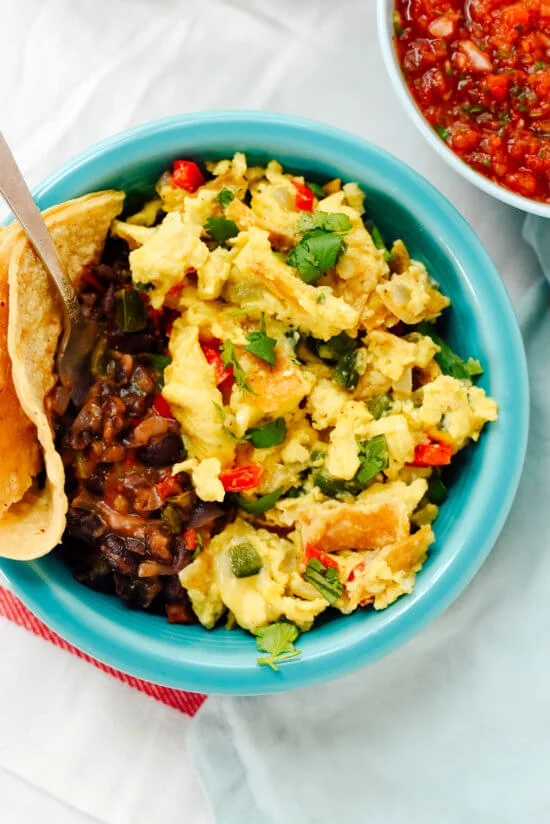
14) Migas
Migas are a popular Portuguese breakfast dish made from leftover bread. They are flavored with garlic, olive oil, and sometimes meat like chouriço or bacon.
To make migas, you’ll start by heating olive oil in a pan and adding chopped garlic. The garlic should be sautéed until it becomes fragrant.
Next, add pieces of stale bread to the pan. Stir the bread so it soaks up the oil and garlic. Season with salt, pepper, and chopped coriander for extra flavor.
If you’re using chouriço or bacon, cook them separately until browned and crispy. Mix the cooked meat with the bread and continue to stir.
Boil a small amount of water and gradually add it to the pan while stirring. The bread will start to break down and absorb the water, creating a soft yet textured mixture.
Migas are often served with poached or fried eggs on top. The eggs add a rich flavor and make the dish heartier.
This dish is simple but flavorful, showcasing the resourcefulness and rich culinary traditions of Portugal. Experiment with different meats and seasonings to find the version you like best.
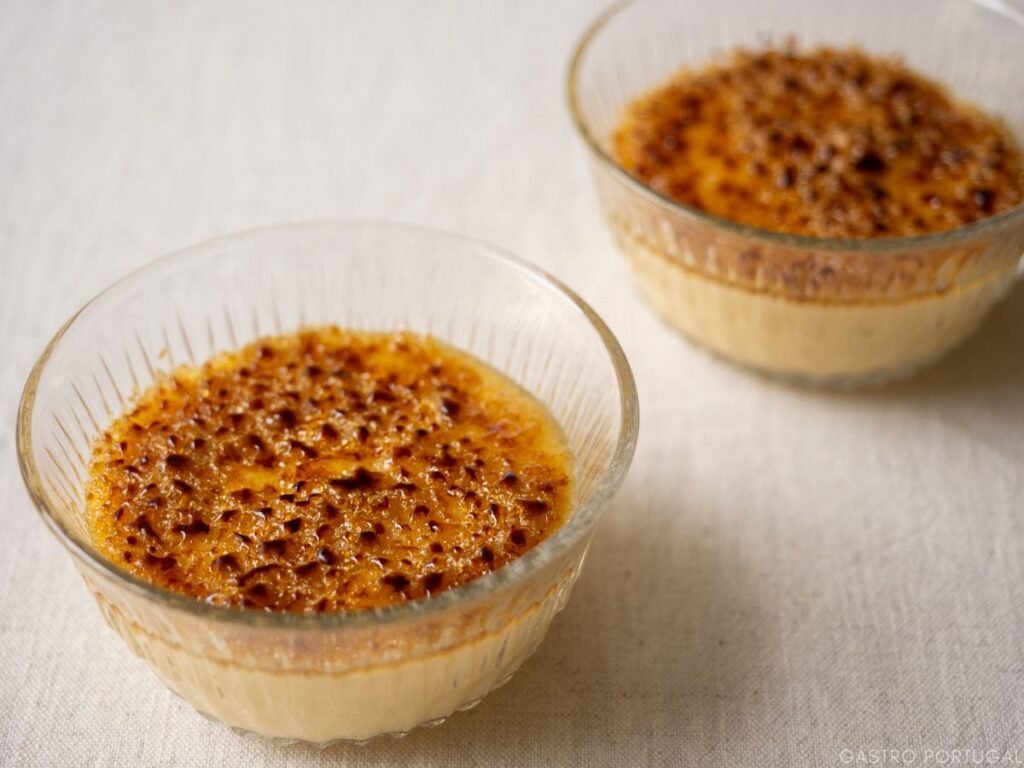
15) Leite Creme
Leite Creme is a traditional Portuguese dessert similar to crème brûlée. It is both simple and delicious.
To prepare Leite Creme, you start by pouring milk into a pan. Add cinnamon, lemon peel, and scraped vanilla seeds. Heat the mixture until it simmers. Then remove it from the heat and let it cool.
In a separate bowl, whisk together egg yolks, sugar, and cornstarch. Slowly pour the cooled milk mixture into the egg mixture while continuing to whisk. This ensures a smooth texture.
Next, return the mixture to the stove. Cook it over medium heat until it thickens. Stir constantly to avoid lumps.
Pour the creamy mixture into individual ramekins. Let them cool to room temperature. If you like, you can chill them in the refrigerator.
Just before serving, sprinkle sugar on top of each ramekin. Use a kitchen torch to caramelize the sugar, creating a crispy, sweet crust.
Enjoy your homemade Leite Creme as a delightful addition to your breakfast or as a standalone treat.
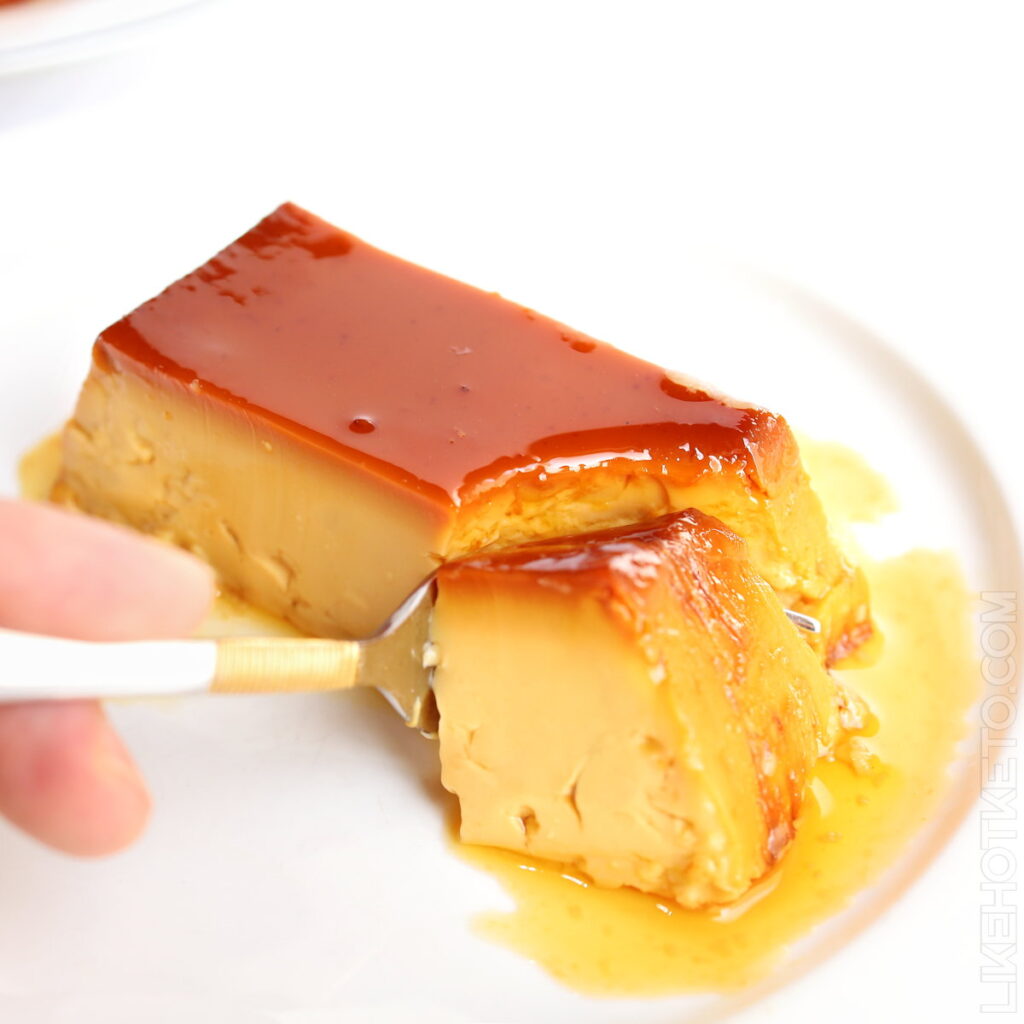
16) Pudim Abade de Priscos
Pudim Abade de Priscos is a traditional Portuguese dessert. It is also known as Abade Prisco’s Pudding. This pudding is unique because it contains a surprising ingredient—ham.
To make this dessert, start by making a caramel. You heat sugar until it melts into a golden, uniform caramel. Then spread this caramel on the sides of your pudding mold.
Next, bring water to a boil with added sugar, bacon, cinnamon, and lemon peels. Simmer until the mixture turns into a syrup. Let it cool.
In a separate bowl, mix Port wine with egg yolks. Combine this mixture with the prepared caramel. Finally, blend everything well.
Pour the mixture into the caramel-coated pudding mold. Bake in a water bath until the pudding is set. This might take about an hour.
Let the pudding cool completely before serving. The result is a smooth, rich dessert with a hint of bacon flavor, which might surprise you. This dish is a delicious example of Portuguese culinary creativity.
Traditional Ingredients and Staples
Portuguese breakfasts are rich in flavor and variety. Key components include various types of bread, as well as a range of spices and herbs that add distinctive tastes to these dishes.
Portuguese Bread Varieties
Portuguese bread is essential to many breakfast dishes. Pão de Deus (Bread of God) is a sweet bread topped with coconut. Broa is a traditional cornbread, dense and moist, often paired with butter or honey.
Papo-seco is a crusty roll, perfect for sandwiches. Bola de Berlim is a Portuguese version of a Berliner doughnut, filled with custard. These breads offer a balance of sweet and savory options to start your day.
Common Spices and Herbs
Spices and herbs are important in Portuguese cooking. Paprika adds a smoky flavor, while cinnamon is often used in sweet dishes like fig jam. Garlic and bay leaves are staples in savory recipes.
Oregano and basil are common in breakfast dishes with tomatoes and eggs. Jalapeños or chili powder may be added for heat. These spices and herbs create distinct and aromatic flavors, essential to Portuguese breakfast cuisine.
Health Benefits of Portuguese Breakfasts
Portuguese breakfasts offer multiple health benefits due to their rich nutritional profiles and ingredients that support immunity. These meals often include fresh and natural components that are both tasty and good for you.
Nutritional Profile
Many Portuguese breakfast recipes are nutrient-dense, meaning they provide essential vitamins and minerals. For example, dishes often use fresh fruits like figs and oranges, which are high in vitamin C and fiber.
Traditional bread made with whole grains supplies complex carbohydrates that give you sustained energy. Eggs and dairy products in these breakfasts offer protein and calcium, crucial for muscle and bone health.
Incorporating a balance of healthy fats, proteins, and carbs can help maintain your energy levels throughout the morning.
Ingredients that Boost Immunity
Ingredients like garlic, onions, and cinnamon frequently appear in Portuguese breakfasts. Garlic and onions are known for their antioxidant and anti-inflammatory properties, which can enhance your immune system.
Figs and citrus fruits, packed with vitamin C, help to fend off common illnesses by boosting your immune response.
Using spices such as cinnamon in fig jam not only adds flavor but also provides antimicrobial benefits.
By including these elements in your breakfast, you can help keep your immune system strong, making it easier to fight off infections and stay healthy.
